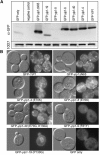Genetic analysis of yeast Yip1p function reveals a requirement for Golgi-localized rab proteins and rab-Guanine nucleotide dissociation inhibitor
- PMID: 15611160
- PMCID: PMC1448722
- DOI: 10.1534/genetics.104.032888
Genetic analysis of yeast Yip1p function reveals a requirement for Golgi-localized rab proteins and rab-Guanine nucleotide dissociation inhibitor
Abstract
Yip1p is the first identified Rab-interacting membrane protein and the founder member of the YIP1 family, with both orthologs and paralogs found in all eukaryotic genomes. The exact role of Yip1p is unclear; YIP1 is an essential gene and defective alleles severely disrupt membrane transport and inhibit ER vesicle budding. Yip1p has the ability to physically interact with Rab proteins and the nature of this interaction has led to suggestions that Yip1p may function in the process by which Rab proteins translocate between cytosol and membranes. In this study we have investigated the physiological requirements for Yip1p action. Yip1p function requires Rab-GDI and Rab proteins, and several mutations that abrogate Yip1p function lack Rab-interacting capability. We have previously shown that Yip1p in detergent extracts has the capability to physically interact with Rab proteins in a promiscuous manner; however, a genetic analysis that covers every yeast Rab reveals that the Rab requirement in vivo is exclusively confined to a subset of Rab proteins that are localized to the Golgi apparatus.
Figures







References
-
- Allan, B. B., B. D. Moyer and W. E. Balch, 2000. Rab1 recruitment of p115 into a cis-SNARE complex: programming budding COPII vesicles for fusion. Science 289: 444–448. - PubMed
-
- Alory, C., and W. E. Balch, 2001. Organization of the Rab-GDI/CHM superfamily: the functional basis for choroideremia disease. Traffic 2: 532–543. - PubMed
-
- Baker, D., L. Hicke, M. Rexach, M. Schleyer and R. Schekman, 1988. Reconstitution of SEC gene product-dependent intercompartmental protein transport. Cell 54: 335–344. - PubMed
Publication types
MeSH terms
Substances
Grants and funding
LinkOut - more resources
Full Text Sources
Molecular Biology Databases

